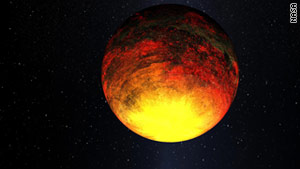
(CNN) -- A NASA spacecraft has detected a rocky planet that is the smallest ever discovered outside the Sun's solar system, the agency announced Monday.
The exoplanet -- so named because it orbits a star other than the Sun -- has been dubbed Kepler-10b. It measures 1.4 times the Earth's diameter and was confirmed after more than eight months of data collection, the agency said. It is the first rocky, or Earth-like, planet discovered by Kepler.
"All of Kepler's best capabilities have converged to yield the first solid evidence of a rocky planet orbiting a star other than our sun," said Natalie Batalha, deputy science team leader for the NASA mission. "The Kepler team made a commitment in 2010 about finding the telltale signatures of small planets in the data, and it's beginning to pay off."
Kepler-10b's size and rocky composition would make it more likely than gaseous planets to contain liquid water, and perhaps life of some kind, if it were the right distance from its star, NASA said. However, it is much too close to the star -- 20 times closer than Mercury is to the Sun.
Kepler-10b's star is about 560 light years from Earth, according to NASA.
Still, the discovery has scientists optimistic about what else Kepler might be able to reveal.
"Although this planet is not in the habitable zone, the exciting find showcases the kinds of discoveries made possible by the mission and the promise of many more to come," said Kepler program scientist Douglas Hudgins.
The mission is the agency's first capable of finding Earth-size planets near the habitable zone, or the distance from a star where a planet can maintain liquid water and potential life.
The spacecraft measures size and other details by noting the tiny decrease in a star's brightness that occurs when a planet crosses in front of it.

No comments:
Post a Comment